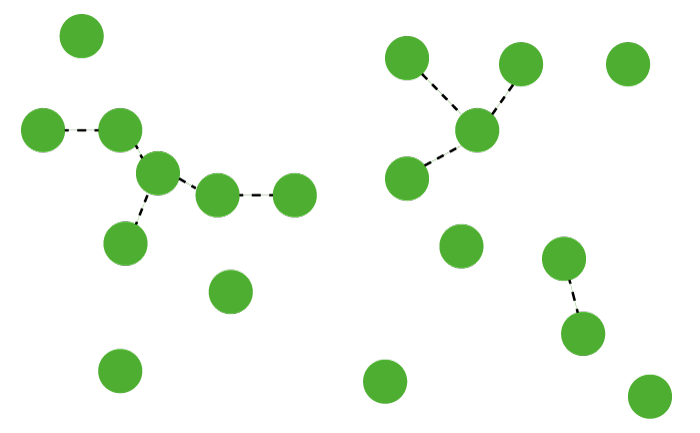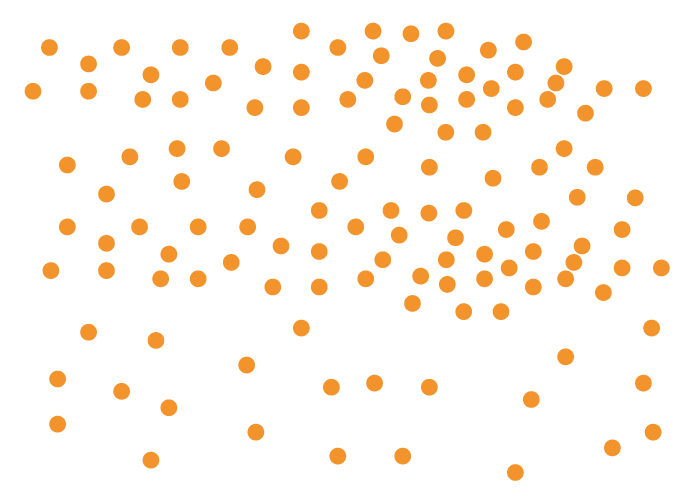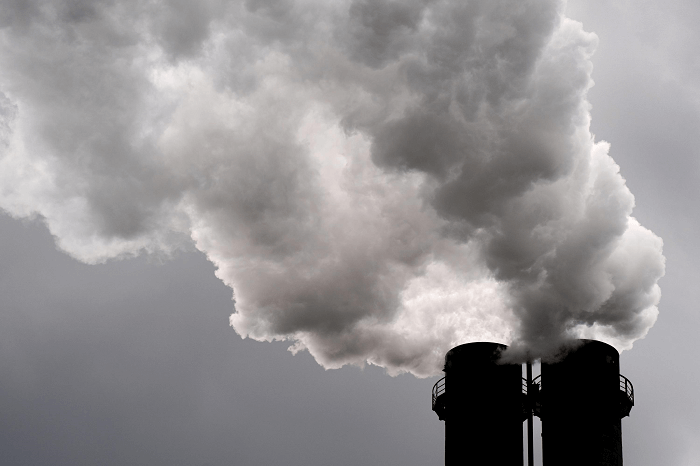Gas DefinitionGas is defined as a form of matter composed of particles that are neither clearly characterized by their shape nor by their volume. Along with the states of matter, which are solids, liquids, and plasma, it is one of the four basic forms of matter. The gas state is intermediate between the liquid and the plasma phases under normal circumstances. Atoms of one element, such as those in H2 or Ar, compounds, such as HCl or CO2, or combinations may make up a gas. (e.g., air, natural gas). The lowermost temperature scale's degenerative quantum gases are attracting an increasing amount of attention. High-density molecular gases that have undergone supercooling to very low temperatures are the constituents of both the Bose and Fermi gases. 
HistoryJan Baptist van Helmont, a Flemish scientist, coined the term "gas" in the early 17th century. He named the first known substance other than air carbon dioxide. Van Helmont was merely adhering to the accepted alchemical practices that were first documented in Paracelsus' writings. In the words of Paracelsus, chaos was "ultra-rarefied water." Another interpretation is that Van Helmont was inspired by the word "gahst" (sometimes called "geist"), which refers to a ghost or spirit. According to historian Jacques Barzun, Van Helmont may have borrowed the phrase via the German word "Gäscht," which denoted the froth created during fermentation. Characteristics of GasesThe gas state of matter has far-reaching distances between its particles. They mimic an "ideal gas" at low temperatures and normal pressure, where the particles have little interaction and collisions are completely elastic. At greater pressures, the effects of the intermolecular bonds between gas particles are more significant. Due to the space between atoms or molecules, the majority of gases are transparent. Some of them, like fluorine and chlorine, have a slight tint. Electric and gravitational forces tend to have less of an impact on gases than on other states of matter. The intermolecular interactions of gas particles are less effective than those of liquid or solid particles because of how far apart they are from one another. These intermolecular pressures are brought on by electrostatic interactions between gas particles. Different gas particles with oppositely charged areas attract one another, whereas those with similar charges repel one another. The fact that these gases have ions that are always charged gives them the name "plasmas." In gases with polar covalent bonds, the compound's net charge remains neutral despite the comparatively strong intermolecular pulls experienced by the molecule as a result of the compounds' inherent charge imbalances. Van der Waals forces are electrostatic interactions produced by transient, unintentionally induced charges that exist across non-polar bonds called covalent bonds of molecules. Many of the physical characteristics of each gas are determined by how these intermolecular forces interplay differently within a substance. By maintaining the boiling temperatures of compounds with ionic and covalent bonds, we can arrive at this conclusion. The sprinkling smoke particulates in the image help us comprehend the behavior of low-pressure gases. Compared to various forms of matter, gases are the least dense and viscous. The particles within a given space are influenced by pressure and temperature. This variation in particle separation and speed is described by compressibility. As can be seen from the accompanying list of refractive indices, particle size, and separation affect gases' optical properties. Finally, gas atoms diffuse or spread out to disperse uniformly across containers. Difference between Plasma and GasIons are atoms or compounds with an electrical charge and can be found in gases. In reality, van der Waals forces frequently cause areas of gas to have sporadic, transient charged regions. Ions with opposite charges draw each other, whereas ions with similar charges repel one another. A form of matter is a plasma rather than a gas if the fluid is completely made up of particles that are charged or if the particles are always charged. 
Gases ExamplesThe temperature and pressure of a material determine whether or not it is a gas. Examples of gases with typical pressure and temperature include:
There are 11 types of chemical gases (12 if you count ozone). Six are monatomic, compared to five homonuclear nuclei.
The periodic table's elemental gases are located on the right side, with the exception of hydrogen, which is located in the upper left corner. Terminologies Related to GasCompressibilityThermodynamicists use this factor (Z) to modify the ideal gas equation to consider the compressibility effects of actual gases. This variable represents the proportion of real to particular ideal volumes. The expansion of the ideal gas law's useable range for design purposes can often be referred to as a "fudge factor" or adjustment. In most cases, this value of Z is quite near 1. The compressibility factor graphic shows Z's variation throughout a variety of extremely cold temperatures. Reynolds metricThe Reynolds number, or R, is a measure of the relationship between viscous and inertial forces in fluid mechanics (vs/L). One of the most significant devoid of dimension numbers in fluid dynamics, it serves as a standard to calculate dynamic similitude. It is typically used in conjunction with other dimensionless numbers. As a result, the Reynolds number acts as a connecting factor between the outcomes of the modeling (design) along with the actual full-scale circumstances. The flow can also be described using it. ViscosityOn September 15, 1999, a satellite image of the weather pattern in the area of the Robinson Crusoe Islands depicted a tumultuous cloud formation known as a Kármán vortex street. The physical characteristic of viscosity gauges how firmly neighbouring molecules adhere to one another. These strong intermolecular interactions enable a solid to endure a shearing force. When subjected to the same load, a fluid will constantly deform. Although viscosity is less in a gas than in a liquid, it is nevertheless a measurable characteristic. The formation of a boundary layer would not occur if gases lacked viscosity because they would not adhere to a wing's surface. The Schlieren image's delta wing can be used to analyse the boundary layer, demonstrating that gas particles adhere to one another. TurbulenceIn a wind tunnel, there is a delta wing. As the gas compresses on this wing's leading edge, the indexes of refraction within it change, creating shadows. Turbulence, also known as turbulent flow, is a type of flow regime that occurs when there are random, unpredictable changes to a fluid's properties. This includes high momentum convection, low momentum diffusion, and abrupt changes in pressure and velocity throughout time and space. One illustration is provided by the satellite image of the weather around the Robinson Crusoe Islands. Limiting layerIn essence, particles will "stick" to an object's surface as it passes through it. The boundary layer is the name given to this layer of particles. Due to surface friction, the object is virtually static at its surface. The object's boundary layer basically gives it a new shape that the surrounding molecules "see" as it gets closer. This boundary layer can potentially detach from the surface, effectively forming a new surface & altering the flow pattern entirely. A stalled air foil is the quintessential illustration of this. As shown in the delta wing image, the boundary layer thickens as the gas moves along the leading edge from right to left. Maximum entropy theoryThe system will be in the macro state corresponding to the maximum multiplicity when the total amount of degrees of freedom approaches infinity. Consider the temperature of the skin of a cold metal bar to provide an example of this concept. Take note of the surface's temperature distribution using thermal imaging of the skin's temperature. A "microstate" is represented by this initial temperature observation. A second skin temperature observation results in a second microstate at a later period. This observation procedure can be carried out repeatedly to generate a number of microstates that depict the surface of the bar's thermal evolution. Selecting the macro state that effectively unifies all of the previous microstates into a single classification makes it possible to characterize this series of microstates. Thermodynamic balanceThe term "thermodynamic equilibrium" refers to the situation where energy transmission from a system stops. This situation often denotes a temperature where heat no longer moves between the system and the environment. Additionally, it indicates that all internal chemical reactions have been finished and that all external forces are in equilibrium (volume remains constant). According to the system under consideration, the timeframe changes for these events. When ice is left to melt at normal temperature, it takes hours. In semiconductors, however, the thermal transfer that takes place when a device switches from an on to an off state could take only a few nanoseconds. 
Microscopic View of Gas MoleculeDefining an object for reference or measurement scale while viewing a gas is standard practice. A grander length scale reflects the gas's macroscopic or global perspective. This area (also known as a volume) must be big enough to hold many gas particles. The "average" behaviour (i.e., velocity, temperature, or pressure) of every gas molecule in the area is determined by the statistical evaluation of this sample size. In contrast, the microscopic or particle perspective relates to a shorter length scale. Macroscopically, the properties of gases are measured either in regards to the gas particles' own properties (velocity, pressure, or temp) or the environment in which they are present (volume). For instance, Robert Boyle spent a brief period of his career studying pneumatic chemistry. In one of his experiments, he examined the macroscopic characteristics of a gas's pressure and volume. A J-tube manometer, which resembles a test tube in its representation of the letter J, was utilized in his experiment. Boyle used a column of mercury to trap an inert gas in the test tube's closed end, keeping the test tube's temperature and particle count constant. He noticed that the volume of the trapped gas reduced as the pressure in the gas grew by adding additional mercury to the column (this is known as an inverse relationship). Boyle multiplied each observation's pressure and volume, and the result was constant. Boyle found that this relationship persisted for every gas, which led to the creation of the law (PV=k), which bears his name and honours his contributions to science. A variety of mathematical techniques are available to examine the properties of gases. These tools, from the Euler equation for inviscid flow to the Navier-Stokes equations that account entirely for viscous effects, get more complex as gases are subjected to severe circumstances. These equations have been modified to fit the circumstances of the relevant gas system. Boyle's lab tools made it possible for him to employ algebra to produce his analytical results. His studies were made possible by the fact that the gases he was researching were under conditions of relatively low pressure and "ideal" behavior. Safety estimates for various flying situations on the used materials are applicable to these ideal relationships. Modern high-tech tools were created to enable the safe exploration of increasingly unusual operating conditions where gases do not anymore behave in an "ideal" way. The solution to such complex dynamic problems as spacecraft reentry is made possible by this sophisticated math, which includes statistics and multivariable calculus. To check if the material characteristics under this loading scenario are suitable, a particular instance is the analysis of a space shuttle reentry shown. The gas no longer exhibits optimum behaviour during this flight regime.
Next TopicGoods Definition
|
 For Videos Join Our Youtube Channel: Join Now
For Videos Join Our Youtube Channel: Join Now
Feedback
- Send your Feedback to [email protected]
Help Others, Please Share










